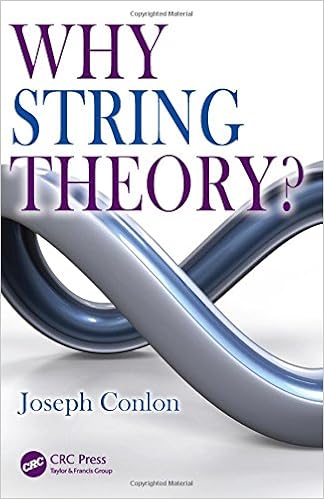 |
| Amazon link: this review is also posted there |
The title suggests that Joseph Conlon’s book is a defence of string theory against its detractors; it is so much more than that.
He begins by reviewing the strengths and limitations of the Standard Model. The Standard Model is a somewhat ramshackle construction which, to the surprise of its constructors, has proven extraordinarily successful and resilient over the decades, culminating in the recent discovery of the predicted Higgs boson at the LHC. We know, however, that the Standard Model is wrong because it assumes a fixed spacetime (i.e. no gravity) - it has proved impossible to successfully quantise gravity within the framework of the Standard Model.
Conlon’s approach is historical. The first inklings of string theory came about through attempts to understand the strong nuclear force in the 1970s, where string harmonics emerged mathematically from observed scattering patterns. It later transpired that the ‘strings’ were an epiphenomenon of the correct quantum field theory – quantum chromodynamics – where the force lines did indeed tend to bunch up into strings. The glory years of QFT saw string theory relegated to a backwater.
The end of the seventies saw attempts to quantise gravity under the assumptions of supersymmetry. It turned out that these ‘supergravity’ theories had severe problems which string theory seemed to solve in a very natural way. Suddenly people began to take notice and the string community rapidly expanded. These were the years of five different string theories, and the realisation that they were all different limits of one underlying theory – M-theory - an insight due to Ed Witten.
The author reviews quantum field theories, string theory and the AdS/CFT correspondence in his characteristically clear way. But after all this work, is there any direct experimental evidence for string theory? Chapter 7 is very short, consisting of this one sentence: ‘There is no direct experimental evidence for string theory.’
Having got that out of the way, Conlon now explains how the complex and sophisticated toolkit of string theory has led to insights across physics. He discusses the use of string theory in facilitating calculations in quantum field theories in their strong coupling regime via the AdS/CFT correspondence; the modelling of heavy ion collisions; applications in mathematics (relating to ‘monstrous moonshine’); predictions of dark matter candidates such as axions; predictions of dark radiation resulting from the theory’s extra spatial dimensions; and of course the opportunity to model black hole microstates, entropy and spacetime topology changes in what is presumed to be string theory’s core competence, quantum gravity.
The author now moves on to mini-portraits of the main kinds of scientists he see in the community around him. We hear about the revolutionaries who wish to kick over the applecart (not so easy). We hear about the worker ants whose slogan is ‘Vorsprung durch Technik’ – those researchers who kick the can of science up the road with their calculations so that experimentation can progress - little chance of glory but employment prospects are good. Under ‘Stockholm or Bust’ we meet the model builders, those hoping to call nature right and get to Sweden – and those who game the system. There are the super-theorists, like Witten, members of the ‘Most Sublime Brahminate of Princeton’, and those who appreciate that ‘il faut cultiver notre jardin’ - who look for unfashionable areas which to their eyes show great promise and are able to deliver.
Conlon’s final two chapters address (in a fair and evenhanded manner) the well-known criticisms of string theory and provide rebuttals. He then explains why string theory remains so dominant in the field and hazards some guesses as to its future.
Understanding the state-of-the-art in fundamental physics is of course hard, the subject is inaccessible for most physicists let alone the broader community. Conlon writes (p. 198):
“Undergraduate physics is an unparalleled intellectual experience: it is a smorgasbord of the deepest and most powerful thoughts that have ever been thunk. You learn physics at a rate of a Nobel Prize a week, and the resulting frisson of the mind is at a level that is never experienced again. Four years takes you from Newtonian gravity through the laws of heat and energy, past Maxwell's synthesis of electromagnetism and into the laws of special and general relativity, from the basics of quantum mechanics to the Standard Model and quantum field theory. It is wonderful and magnificent.”Sadly, beyond these well-explored paths there is the slog of the new, where progress slows to a crawl. In this book Professor Conlon has provided – as he promises in his preface - an astonishingly clear tour of modern physics. It is hard to think of a better, clearer or wittier review, and one which will be particularly useful to science undergraduates curious as to where their field is heading. School students who have done some reading around the subject (e.g. who have read books by Brian Greene) might also find this work of great value. It’s highly recommended.
At long last I have read this book. I had hoped for more String Theory detail including some semi-mathematical discussions of the subject. The "history" aspect has been covered in other works, as has the "sociology" aspects.
ReplyDeleteYes, there are a few String Theory textbooks out there, at least one claiming to be undergraduate-accessible.
Delete